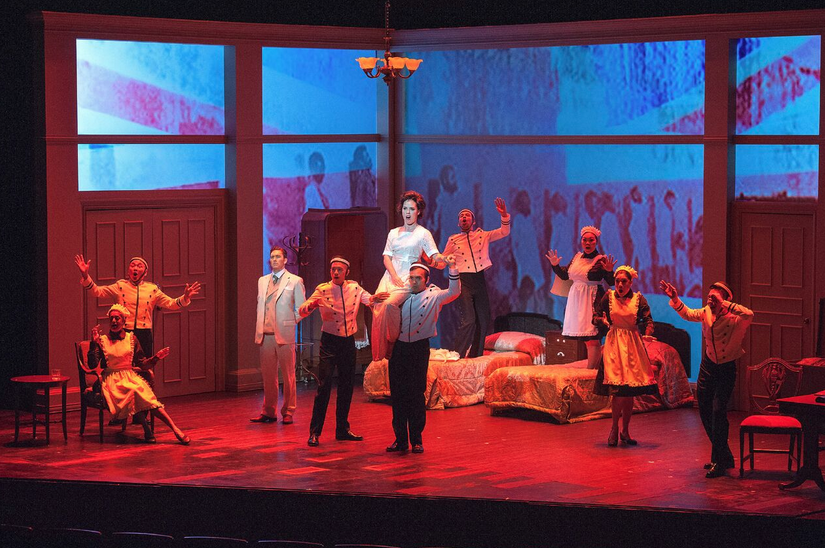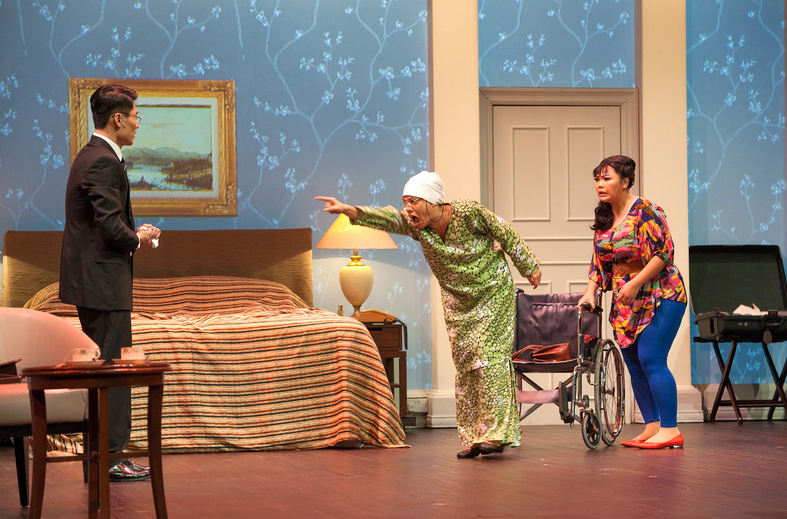The introduction to part two of the epic Hotel comes again by way of welcoming, choreographed hotel staff, now with nylon, wheeled suitcases. Their uniforms are unisex chinos with matching Nehru jackets, and their demeanour seems more relaxed and certainly less servile. As the next decade rolls in, the disco ball is not the only indicator we are not in 1915 any more.
 Hotel at the OzAsia Festival. Photo © W!LD RICE
Hotel at the OzAsia Festival. Photo © W!LD RICE
The surprises of the 1975 scene where anything goes culminate with larger than life-size cocks (not the type that crow) that bounce around the stage. The actor’s faces peek out of flesh coloured apertures in the shaft, with an amusement suggesting this is the best gig they’ve ever had. The ludicrousness is unashamedly over the top, if not downright blush-worthy, but it has its desired effect.
This fantastic vignette presents something of a challenge for Hotel. This tale is linear, which places the 70s approximately two-thirds of the way through. Playwrights Marcia Vanderstraaten and Alfian Sa’at clearly had a blast writing this scene as did the performers bringing it to life. It’s nothing short of outrageous, and rightly so. If legend can be believed, there was no shortage of material surrounding the infamous Bugis Street to draw from. And draw they did, without sparing the details.
The energy and surrealism of the scene suggests that we’ve reached the summit of this epic, but there are still four decades left, and whilst the remainder is in turn, compelling, devastating, funny and clever, the only way out, it seems, is down. It’s a decision that makes our exit from this wonderful Hotel slightly anticlimactic, and rather than departing, instilled with hope that our next visit will be just as fabulous, we just leave. That might be the point. After all, it is only a hotel.
 Hotel at the OzAsia Festival. Photo © W!LD RICE
Hotel at the OzAsia Festival. Photo © W!LD RICE
Part two contains abundant charisma and passion, helped by splendid memory-inducing aerobics and PAC-MAN-inspired dance moves, thank you 1985, and the delicious unfolding of the marriage episode. Unfortunately, some prop failures in the naughties, whilst handled well, sadly broke the spell, albeit temporarily.
By the time we get to 2015, there have been plenty more laughs and again, quality acting, most notably from Pam Oei as Lisa’s mother, and later as Mrs Yao. Oei brings to the former role exactly the sort of crippling fear that some mothers and mothers-in-law can choose to foster (you know who you are). The final scene acts as something of a bookend, which leads not to the expected big bang conclusion, but to a quiet contemplation.
Few contentious issues are left unexplored, as props, people and themes from part one return to haunt us. Piecing it all together is a strain for those of us not blessed with hyperthymesia, but the attempt is worth the investment. Tying up loose plot ends does not seem to be the particular point of Hotel, but rather, gaining some insight into the sum of the parts.
Parallels to present day controversies are everywhere and this is part of the reason for Hotel’s success. At face value, there are poignant and riotous tales with wonderful and entertaining characters, but a little deeper, this complex production offers significant challenges for the future, backed with a profound understanding of history.
Despite part one winning the show of strength over the sequel, Hotel is a triumph, without reservation.
Hotel is at the Adelaide Festival Centre as part of the OzAsia Festival until September 30.











Comments
Log in to join the conversation.